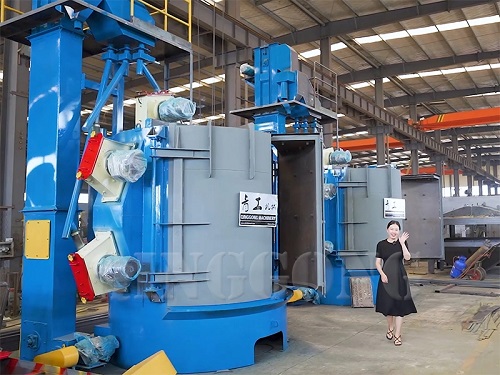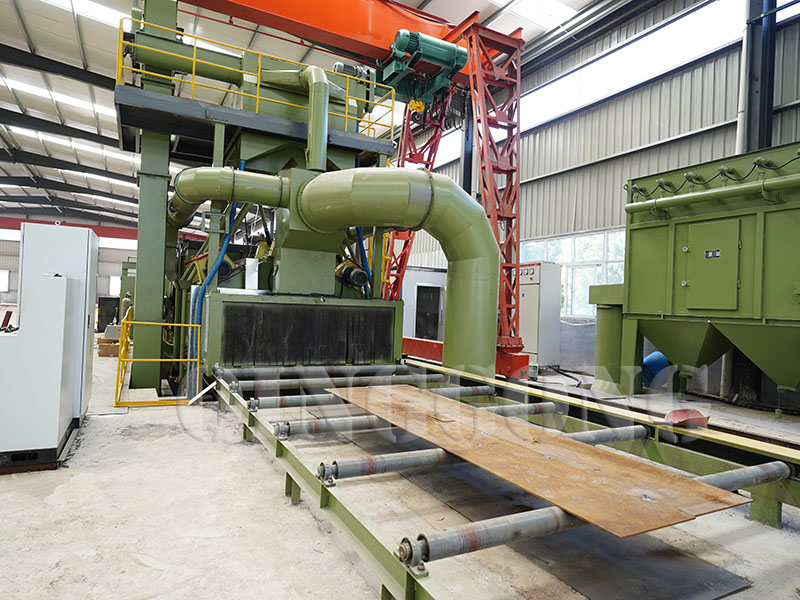Many people don't understand. The cleaning of castings is not only by shot blasting. For large parts, it is generally necessary to clean the drum first, which is to remove the riser of the casting and place it in the drum. The pieces are in the drum. When they collide, most of the sand on the surface is removed before shot blasting. With the development of the economy, the shot blasting machine has become one of the indispensable processing machinery for many machinery manufacturers and shot peening equipment manufacturers. Nowadays, the types of shot blasting machines produced on the market are different, and distinguishing them has become a puzzle for buyers. So how does the shot blasting machine achieve a uniform shot blasting effect? How to judge whether the shot blasting machine is good or bad?
Ⅰ. How to distinguish the quality of the shot blasting machine?
1. Check whether the shot blasting machine of the shot blasting machine is in good condition;
2. Check whether the welding of the cylinder is fine enough;
3. The shot blasting machine should check whether the material of the guard plate is durable;
4. The main thing is to look at the cleaning effect. After the accessories enter the shot blasting room, the excellent processing effect is a good shot blasting machine, which is related to the angle of the head and the speed of shot blasting;
5. Look at the time of use. The more time you use, the better;
6. Whether the guard plate of the sand blasting room is durable depends on what material it is made of;
7. The vibration sound and dust removal effect when starting up should also be checked. If the cleaning effect is qualified and the noise level cannot meet the standard, then this is also an unqualified shot blasting machine
8. Check the integrity of each part and whether it lacks accessories.
Ⅱ. How to adjust the shot blasting machine angle?
1. Place a lightly rusted steel plate or a steel plate with marking paint in the shot blasting area.
2. Start the shot blaster, and the motor accelerates to the appropriate speed.
3. Use the control valve (manually) to open the shot blasting gate. After about 5 seconds, the shot material is sent to the impeller, and the metal rust on the slightly rusted steel plate is removed.
4. To determine the ejection position, use a 19MM adjustable wrench to loosen the three hexagonal bolts on the pressure plate until the directional sleeve can be turned by hand, and then tighten the directional sleeve.
5. Prepare a new projectile chart to verify the best settings.
Ⅲ. How does the shot blasting machine achieves a uniform shot blasting effect?
Studies have shown that tensile stress on the surface of metal materials is much easier than compressive stress in terms of damage. When the surface is under compressive stress, the fatigue life of the material is greatly improved. Therefore, spraying is usually used for components that are prone to fatigue fracture, such as shafts. The pellets form surface compressive stress and increase product life. In addition, metal materials are susceptible to stretching. This is the reason why the tensile strength of the material is much lower than the compressive strength. This is also the reason why metal materials generally use tensile strength to express material properties.
The working surface of the steel plate of the car we drive every day is strengthened by shot peening, which can significantly improve the material's fatigue strength and extend the car's life. A motor rotates the impeller body of the abrasive shot blasting machine. Using centrifugal force, shots with diameters ranging from 0.2 to 3.0mm are thrown onto the surface of the workpiece, causing the surface to roughen, making the workpiece beautiful, or changing the workpiece. Welding tensile stress is compressive stress, which increases the workpiece's service life. In almost all areas of the machinery, shot blasting machines are used.
Shot blasting can clean and decontaminate the workpiece. The purpose is to prepare for the following sequence. It not only ensures the roughness requirements of the next procedure but also ensures the consistency of the clean surface. Shot blasting has a strengthening effect on the workpiece and is precise. Casting uses shot blasting machines for shot blasting of workpieces almost every day.
 EN
EN
 fr
fr  de
de  es
es  it
it  ru
ru  pt
pt  ar
ar  th
th  pl
pl  ro
ro 


